Climate Change Impacts on Water Resources in the Danube River Basin: A Hydrological Modelling Study Using EURO-CORDEX Climate Scenarios
Abstract
:1. Introduction
2. Materials and Methods
2.1. The Danube River Basin
2.2. The Mechanistic Hydrological Model PROMET
2.3. Regional Climate Models as Meteorological Drivers
2.3.1. Selection of Appropriate Climate Models
- RACMO22Ev1 (RCM) driven with ICHEC-EC-EARTH (r12) (GCM) (denoted as ICHEC-RACMO in this study);
- RCA4v1 (RCM) driven with ICHEC-EC-EARTH (r12) (GCM) (denoted as ICHEC-RCA4 in this study);
- RCA4v1a (RCM) driven with MPI-M-MPI-ESM-LR (r1) (GCM) (denoted as MPI-RCA4 in this study).
2.3.2. Bias Correction of Climate Model Simulations
3. Results
3.1. Temperature and Precipitation
3.1.1. Basin-Wide and Regional Trends
3.1.2. Changes in Seasonality
3.1.3. Changes in Spatial Patterns
3.2. Soil Water Content, Plant Water Stress and Snow Water Equivalent
3.2.1. Changes in Seasonality
3.2.2. Changes in Spatial Patterns
3.3. Discharge
3.3.1. Annual and Seasonal Trends in Danube Sub-Basins
3.3.2. Changes in Spatial Patterns
3.3.3. Changes in the Risk of High and Low Flows
4. Discussion
4.1. The Big Picture
4.1.1. Trends of Temperature and Precipitation
4.1.2. Trends of Soil Water Content, Plant Water Stress and Snow Water Equivalent
4.1.3. Trends of Discharge
4.2. Sources of Uncertainties
5. Conclusions
Author Contributions
Funding
Data Availability Statement
Conflicts of Interest
References
- Intergovernmental Panel on Climate Change (IPCC). Summary for Policymakers. In Climate Change 2021: The Physical Science Basis. Contribution of Working Group I to the Sixth Assessment Report of the Intergovernmental Panel on Climate Change; Masson-Delmotte, V., Zhai, P., Pirani, A., Connors, S.L., Péan, C., Berger, S., Caud, N., Chen, Y., Goldfarb, L., Gomis, M.I., et al., Eds.; Cambridge University Press: Cambridge, UK; New York, NY, USA, 2021; pp. 3–32. [Google Scholar]
- United Nations Framework Convention on Climate Change (UNFCCC). Adoption of the Paris Agreement, 21st Conference of the Parties; United Nations: Paris, France, 2015. [Google Scholar]
- Arias, P.A.; Bellouin, N.; Coppola, E.; Jones, R.G.; Krinner, G.; Marotzke, J.; Naik, V.; Palmer, M.D.; Plattner, G.-K.; Rogelj, J.; et al. Technical Summary. In Climate Change 2021: The Physical Science Basis. Contribution of Working Group I to the Sixth Assessment Report of the Intergovernmental Panel on Climate Change; Masson-Delmotte, V., Zhai, P., Pirani, A., Connors, S.L., Péan, C., Berger, S., Caud, N., Chen, Y., Goldfarb, L., Gomis, M.I., et al., Eds.; Cambridge University Press: Cambridge, UK; New York, NY, USA, 2021; pp. 33–144. [Google Scholar]
- Doblas-Reyes, F.J.; Sörensson, A.A.; Almazroui, M.; Dosio, A.; Gutowski, W.J.; Haarsma, R.; Hamdi, R.; Hewitson, B.; Kwon, W.-T.; Lamptey, B.L.; et al. Linking Global to Regional Climate Change. In Climate Change 2021: The Physical Science Basis. Contribution of Working Group I to the Sixth Assessment Report of the Intergovernmental Panel on Climate Change; Masson-Delmotte, V., Zhai, P., Pirani, A., Connors, S.L., Péan, C., Berger, S., Caud, N., Chen, Y., Goldfarb, L., Gomis, M.I., et al., Eds.; Cambridge University Press: Cambridge, UK; New York, NY, USA, 2021; pp. 1363–1512. [Google Scholar]
- Kjellström, E.; Nikulin, G.; Strandberg, G.; Christensen, O.B.; Jacob, D.; Keuler, K.; Lenderink, G.; van Meijgaard, E.; Schär, C.; Somot, S.; et al. European climate change at global mean temperature increases of 1.5 and 2 °C above pre-industrial conditions as simulated by the EURO-CORDEX regional climate models. Earth Syst. Dynam. 2018, 9, 459–478. [Google Scholar] [CrossRef] [Green Version]
- Iturbide, M.; Fernández, J.; Gutiérrez, J.M.; Bedia, J.; Cimadevilla, E.; Díez-Sierra, J.; Manzanas, R.; Casanueva, A.; Baño-Medina, J.; Milovac, J.; et al. Repository Supporting the Implementation of FAIR Principles in the IPCC-WG1 Atlas. 2021. Available online: https://github.com/IPCC-WG1/Atlas (accessed on 14 November 2022).
- Gutiérrez, J.M.; Jones, R.G.; Narisma, G.T.; Alves, L.M.; Amjad, M.; Gorodetskaya, I.V.; Grose, M.; Klutse, N.A.B.; Krakovska, S.; Li, J.; et al. Atlas; Cambridge University Press: Cambridge, UK; New York, NY, USA, 2021. [Google Scholar]
- Dogaru, D.; Mauser, W.; Balteanu, D.; Krimly, T.; Lippert, C.; Sima, M.; Szolgay, J.; Kohnova, S.; Hanel, M.; Nikolova, M.; et al. Irrigation Water Use in the Danube Basin: Facts, Governance and Approach to Sustainability. J. Environ. Geogr. 2019, 12, 1–12. [Google Scholar] [CrossRef] [Green Version]
- International Commission for the Protection of the Danube River (ICPDR). Climate Change Adaptation Strategy; ICPDR: Vienna, Austria, 2019. [Google Scholar]
- ICPDR/LMU. Revision and Update of the Danube Study. Integrating and Editing New Scientific Results in Climate Change Research and the Resulting Impacts on Water Availability to Revise the Existing Adaptation Strategies in the Danube River Basin; Ludwig-Maximilians-Universität: Munich, Germany, 2018. [Google Scholar]
- Stagl, J.C.; Hattermann, F.F. Impacts of Climate Change on the Hydrological Regime of the Danube River and Its Tributaries Using an Ensemble of Climate Scenarios. Water 2015, 7, 6139–6172. [Google Scholar] [CrossRef]
- Krysanova, V.; Hattermann, F.; Wechsung, F. Development of the ecohydrological model SWIM for regional impact studies and vulnerability assessment. Hydrol. Process. 2005, 19, 763–783. [Google Scholar] [CrossRef]
- Van der Linden, P.; Mitchell, J.F.B. ENSEMBLES: Climate Change and Its Impacts: Summary of Research and Results from the ENSEMBLES Project; Met Office Hadley Centre: Exeter, UK, 2009; p. 160.
- Meehl, G.A.; Covey, C.; Delworth, T.; Latif, M.; McAvaney, B.; Mitchell, J.F.B.; Stouffer, R.J.; Taylor, K.E. THE WCRP CMIP3 Multimodel Dataset: A New Era in Climate Change Research. Bull. Am. Meteorol. Soc. 2007, 88, 1383–1394. [Google Scholar] [CrossRef] [Green Version]
- Stagl, J.C.; Hattermann, F.F. Impacts of Climate Change on Riverine Ecosystems: Alterations of Ecologically Relevant Flow Dynamics in the Danube River and Its Major Tributaries. Water 2016, 8, 566. [Google Scholar] [CrossRef] [Green Version]
- Taylor, K.E.; Stouffer, R.J.; Meehl, G.A. An Overview of CMIP5 and the Experiment Design. Bull. Am. Meteorol. Soc. 2012, 93, 485–498. [Google Scholar] [CrossRef] [Green Version]
- Maraun, D.; Wetterhall, F.; Ireson, A.M.; Chandler, R.E.; Kendon, E.J.; Widmann, M.; Brienen, S.; Rust, H.W.; Sauter, T.; Themeßl, M.; et al. Precipitation downscaling under climate change: Recent developments to bridge the gap between dynamical models and the end user. Rev. Geophys. 2010, 48, 1–34. [Google Scholar] [CrossRef] [Green Version]
- Bisselink, B.; Roo, A.d.; Bernhard, J.; Gelati, E. Future projections of water scarcity in the Danube River Basin due to land use, water demand and climate change. J. Environ. Geogr. 2018, 11, 25–36. [Google Scholar] [CrossRef] [Green Version]
- De Roo, A.P.J.; Wesseling, C.G.; Van Deursen, W.P.A. Physically based river basin modelling within a GIS: The LISFLOOD model. Hydrol. Process. 2000, 14, 1981–1992. [Google Scholar] [CrossRef]
- Van Der Knijff, J.M.; Younis, J.; De Roo, A.P.J. LISFLOOD: A GIS-based distributed model for river basin scale water balance and flood simulation. Int. J. Geogr. Inf. Sci. 2010, 24, 189–212. [Google Scholar] [CrossRef]
- Jacob, D.; Petersen, J.; Eggert, B.; Alias, A.; Christensen, O.B.; Bouwer, L.M.; Braun, A.; Colette, A.; Déqué, M.; Georgievski, G.; et al. EURO-CORDEX: New high-resolution climate change projections for European impact research. Reg. Environ. Change 2014, 14, 563–578. [Google Scholar] [CrossRef]
- Mauser, W.; Bach, H. PROMET—Large scale distributed hydrological modelling to study the impact of climate change on the water flows of mountain watersheds. J. Hydrol. 2009, 376, 362–377. [Google Scholar] [CrossRef]
- Probst, E.; Mauser, W. Evaluation of ERA5 and WFDE5 forcing data for hydrological modelling and the impact of bias correction with regional climatologies: A case study in the Danube River Basin. J. Hydrol. Reg. Stud. 2022, 40, 101023. [Google Scholar] [CrossRef]
- Intergovernmental Panel on Climate Change (IPCC). Summary for Policymakers. In Climate Change 2014: Synthesis Report. Contribution of Working Groups I, II and III to the Fifth Assessment Report of the Intergovernmental Panel on Climate Change; Core Writing Team, Pachauri, R.K., Meyer, L.A.E., Eds.; IPCC: Geneva, Switzerland, 2014; p. 151. [Google Scholar]
- Jungwirth, M.; Haidvogl, G.; Hohensinner, S.; Waidbacher, H.; Zauner, G. Österreichs Donau. Landschaft—Fisch—Geschichte; Institut für Hydrobiologie u. Gewässermanagement, BOKU: Vienna, Austria, 2014; p. 420. [Google Scholar]
- Schiller, H.; Miklós, D.; Sass, J. Chapter 2. The Danube River and its Basin Physical Characteristics, Water Regime and Water Balance. In Hydrological Processes of the Danube River Basin; Brilly, M., Ed.; Springer: Dordrecht, The Netherlands; Heidelberg, Germany; London, UK; New York, NY, USA, 2010; pp. 25–77. [Google Scholar]
- Farr, T.G.; Rosen, P.A.; Caro, E.; Crippen, R.; Duren, R.; Hensley, S.; Kobrick, M.; Paller, M.; Rodriguez, E.; Roth, L.; et al. The Shuttle Radar Topography Mission. Rev. Geophys. 2007, 45, 1–33. [Google Scholar] [CrossRef] [Green Version]
- Lehner, B.; Verdin, K.; Jarvis, A. New Global Hydrography Derived from Spaceborne Elevation Data. Eos 2008, 89, 93–94. [Google Scholar] [CrossRef]
- Global Runoff Data Centre (GRDC). The Global Runoff Data Centre. 2019. Available online: https://grdc.bafg.de (accessed on 14 November 2022).
- International Commission for the Protection of the Danube River (ICPDR). Danube River Basin Water Quality Database. 2021. Available online: https://www.icpdr.org/wq-db/ (accessed on 14 November 2022).
- Esri. “World Imagery” [basemap]. Scale Not Given. “World Imagery”, 8 November 2022. 2009. Available online: https://www.arcgis.com/home/item.html?id=10df2279f9684e4a9f6a7f08febac2a9 (accessed on 18 November 2022).
- Beck, H.E.; Zimmermann, N.E.; McVicar, T.R.; Vergopolan, N.; Berg, A.; Wood, E.F. Present and future Köppen-Geiger climate classification maps at 1-km resolution. Sci. Data 2018, 5, 180214. [Google Scholar] [CrossRef] [Green Version]
- Kovács, P. Chapter 5. Characterization of the Runoff Regime and Its Stability in the Danube Catchment. In Hydrological Processes of the Danube River Basin; Brilly, M., Ed.; Springer: Dordrecht, The Netherlands; Heidelberg, Germany; London, UK; New York, NY, USA, 2010; pp. 143–173. [Google Scholar]
- Mauser, W.; Prasch, M.; Weidinger, R.; Stöber, S. GLOWA-Danube. In Regional Assessment of Global Change Impacts: The Project GLOWA-Danube; Mauser, W., Prasch, M., Eds.; Springer International Publishing: Cham, Germany, 2016; pp. 3–18. [Google Scholar]
- Regionale Zusammenarbeit der Donauländer (RZD). Die Donau und ihr Einzugsgebiet. Eine hydrologische Monographie. Teil 1: Texte; Bayerisches Landesamt für Wasserwirtschaft: Munich, Germany, 1986; p. 377. [Google Scholar]
- Hank, T.B.; Bach, H.; Mauser, W. Using a Remote Sensing-Supported Hydro-Agroecological Model for Field-Scale Simulation of Heterogeneous Crop Growth and Yield: Application for Wheat in Central Europe. Remote Sens. 2015, 7, 3934–3965. [Google Scholar] [CrossRef] [Green Version]
- Mauser, W.; Klepper, G.; Zabel, F.; Delzeit, R.; Hank, T.; Putzenlechner, B.; Calzadilla, A. Global biomass production potentials exceed expected future demand without the need for cropland expansion. Nat. Commun. 2015, 6, 8946. [Google Scholar] [CrossRef] [Green Version]
- Zabel, F.; Putzenlechner, B.; Mauser, W. Global Agricultural Land Resources—A High Resolution Suitability Evaluation and Its Perspectives until 2100 under Climate Change Conditions. PLoS ONE 2014, 9, e107522. [Google Scholar] [CrossRef]
- Farquhar, G.D.; von Caemmerer, S.; Berry, J.A. A biochemical model of photosynthetic CO2 assimilation in leaves of C3 species. Planta 1980, 149, 78–90. [Google Scholar] [CrossRef] [Green Version]
- Chen, D.-X.; Coughenour, M.B.; Knapp, A.K.; Owensby, C.E. Mathematical simulation of C4 grass photosynthesis in ambient and elevated CO2. Ecol. Modell. 1994, 73, 63–80. [Google Scholar] [CrossRef]
- Ball, J.T.; Woodrow, I.E.; Berry, J.A. A model predicting stomatal conductance and its contribution to the control of photosynthesis under different environmental conditions. In Progress in Photosynthesis Research. Proceedings of the VIIth International Congress on Photosynthesis, Providence, RI, USA, 10–15 August 1986; Biggins, J., Ed.; Springer Science+Business Media: Dordrecht, The Netherlands, 1987; pp. 221–224. [Google Scholar]
- Jarvis, P.G.; Morison, J.I.L. The control of transpiration and photosynthesis by stomata. In Stomatal Physiology; Jarvis, P.G., Mansfield, T.A., Eds.; Cambridge University Press: Cambridge, UK, 1981; pp. 247–279. [Google Scholar]
- Cunge, J.A. On the Subject of a Flood Propagation Computation Method (Muskingum Method). J. Hydraul. Res. 1969, 7, 205–230. [Google Scholar] [CrossRef]
- Todini, E. A mass conservative and water storage consistent variable parameter Muskingum-Cunge approach. Hydrol. Earth Syst. Sci. 2007, 11, 1645–1659. [Google Scholar] [CrossRef] [Green Version]
- Marke, T.; Mauser, W.; Pfeiffer, A.; Zängl, G.; Jacob, D.; Strasser, U. Application of a hydrometeorological model chain to investigate the effect of global boundaries and downscaling on simulated river discharge. Environ. Earth Sci. 2014, 71, 4849–4868. [Google Scholar] [CrossRef]
- FAO/IIASA/ISRIC/ISSCAS/JRC. Harmonized World Soil Database (Version 1.2). 2012. Available online: http://www.fao.org/soils-portal/soil-survey/soil-maps-and-databases/harmonized-world-soil-database-v12/en/ (accessed on 14 November 2022).
- European Environmental Agency (EEA). CORINE Land Cover (CLC2012). 2012. Available online: https://land.copernicus.eu/pan-european/corine-land-cover/clc-2012 (accessed on 14 November 2022).
- European Space Agency (ESA). Land Cover CCI Product User Guide Version 2 Technical Report 2015. Available online: http://maps.elie.ucl.ac.be/CCI/viewer/download/ESACCI-LC-Ph2-PUGv2_2.0.pdf (accessed on 14 November 2022).
- EUROSTAT. Crops by Classes of Utilised Agricultural Area in Number of Farms and Hectare by NUTS 2 Regions (ef_lus_allcrops). 2013. Available online: https://ec.europa.eu/eurostat/web/agriculture/data/database (accessed on 14 November 2022).
- Zier, C.; Müller, C.; Komischke, H.; Steinbauer, A.; Bäse, F. Das Bayerische Klimaprojektionsensemble—Audit und Ensemblebildung; Bayerisches Landesamt für Umwelt (LfU): Augsburg, Germany, 2020; p. 55. [Google Scholar]
- Smiatek, G.; Kunstmann, H.; Senatore, A. EURO-CORDEX regional climate model analysis for the Greater Alpine Region: Performance and expected future change. J. Geophys. Res. Atmos. 2016, 121, 7710–7728. [Google Scholar] [CrossRef] [Green Version]
- Lazić, I.; Tošić, M.; Djurdjević, V. Verification of the EURO-CORDEX RCM Historical Run Results over the Pannonian Basin for the Summer Season. Atmosphere 2021, 12, 714. [Google Scholar] [CrossRef]
- Torma, C.Z. Detailed validation of EURO-CORDEX and Med-CORDEX regional climate model ensembles over the Carpathian Region. Idojaras 2019, 123, 217–240. [Google Scholar] [CrossRef]
- Kotlarski, S.; Keuler, K.; Christensen, O.B.; Colette, A.; Déqué, M.; Gobiet, A.; Goergen, K.; Jacob, D.; Lüthi, D.; van Meijgaard, E.; et al. Regional climate modeling on European scales: A joint standard evaluation of the EURO-CORDEX RCM ensemble. Geosci. Model Dev. 2014, 7, 1297–1333. [Google Scholar] [CrossRef] [Green Version]
- Fick, S.E.; Hijmans, R.J. WorldClim 2: New 1-km spatial resolution climate surfaces for global land areas. Int. J. Climatol. 2017, 37, 4302–4315. [Google Scholar] [CrossRef]
- Früh, B.; Schipper, H.; Pfeiffer, A.; Wirth, V. A pragmatic approach for downscaling precipitation in alpine-scale complex terrain. Meteorol. Z. 2006, 15, 631–646. [Google Scholar] [CrossRef]
- Frei, C.; Schär, C. A precipitation climatology of the Alps from high-resolution rain-gauge observations. Int. J. Climatol. 1998, 18, 873–900. [Google Scholar] [CrossRef]
- Pepin, N.C.; Arnone, E.; Gobiet, A.; Haslinger, K.; Kotlarski, S.; Notarnicola, C.; Palazzi, E.; Seibert, P.; Serafin, S.; Schöner, W.; et al. Climate Changes and Their Elevational Patterns in the Mountains of the World. Rev. Geophys. 2022, 60, e2020RG000730. [Google Scholar] [CrossRef]
- Bisselink, B.; Bernhard, J.; Gelati, E.; Jacobs, C.; Adamovic, M.; Mentaschi, L.; Lavalle, C.; de Roo, A. Impact of a Changing Climate, Land Use, and Water Usage on Water Resources in the Danube River Basin; EUR 29228 EN; Publications Office of the European Union: Luxembourg, Luxembourg, 2018. [Google Scholar] [CrossRef]
- Todaro, V.; D’Oria, M.; Secci, D.; Zanini, A.; Tanda, M.G. Climate Change over the Mediterranean Region: Local Temperature and Precipitation Variations at Five Pilot Sites. Water 2022, 14, 2499. [Google Scholar] [CrossRef]
- Mersin, D.; Tayfur, G.; Vaheddoost, B.; Safari, M.J.S. Historical Trends Associated with Annual Temperature and Precipitation in Aegean Turkey, Where Are We Heading? Sustainability 2022, 14, 13380. [Google Scholar] [CrossRef]
- Kastridis, A.; Kamperidou, V.; Stathis, D. Dendroclimatological Analysis of Fir (A. borisii-regis) in Greece in the frame of Climate Change Investigation. Forests 2022, 13, 879. [Google Scholar] [CrossRef]
- Kundzewicz, Z.W.; Krysanova, V.; Benestad, R.E.; Hov, Ø.; Piniewski, M.; Otto, I.M. Uncertainty in climate change impacts on water resources. Environ. Sci. Policy 2018, 79, 1–8. [Google Scholar] [CrossRef]
- Vetter, T.; Huang, S.; Aich, V.; Yang, T.; Wang, X.; Krysanova, V.; Hattermann, F. Multi-model climate impact assessment and intercomparison for three large-scale river basins on three continents. Earth Syst. Dynam. 2015, 6, 17–43. [Google Scholar] [CrossRef]


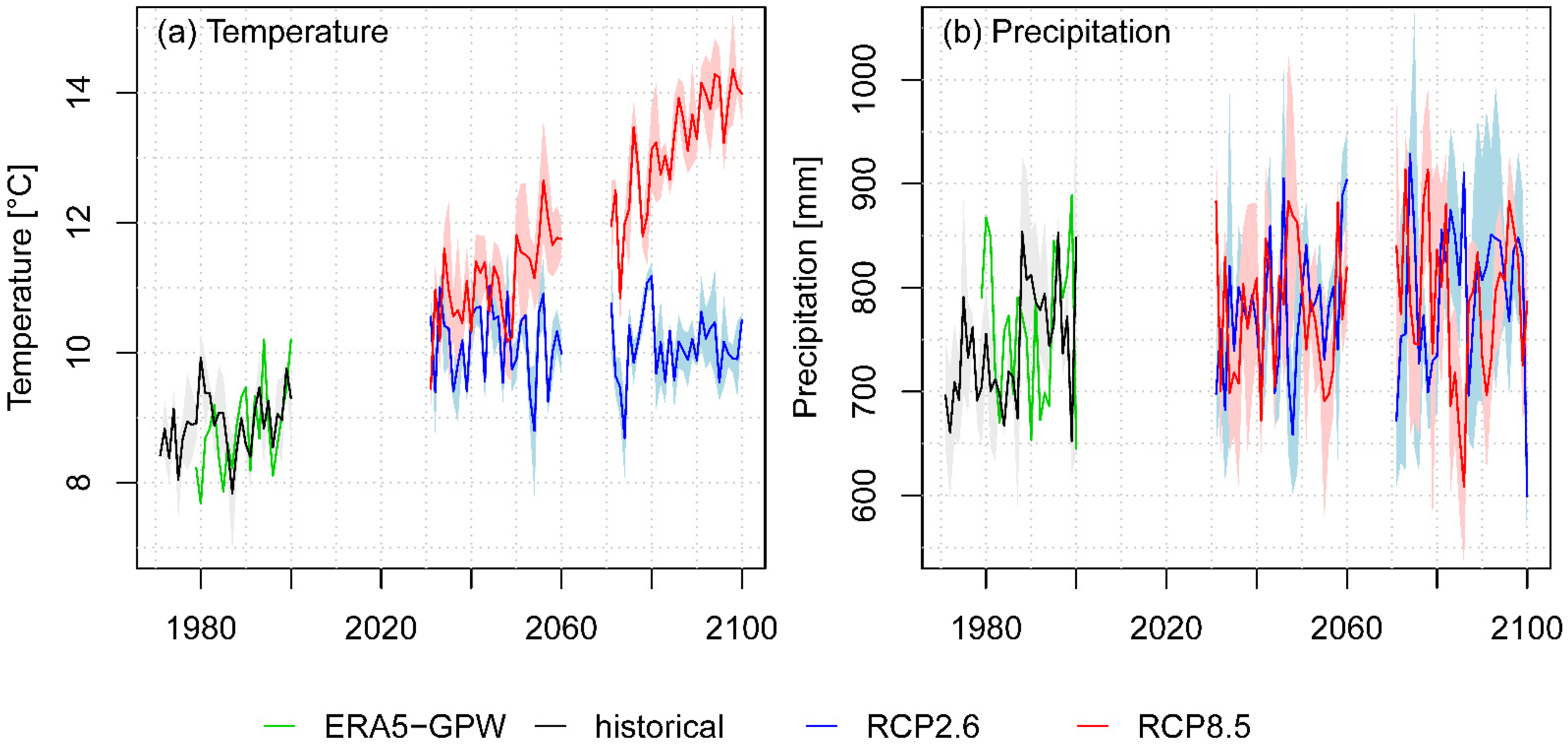
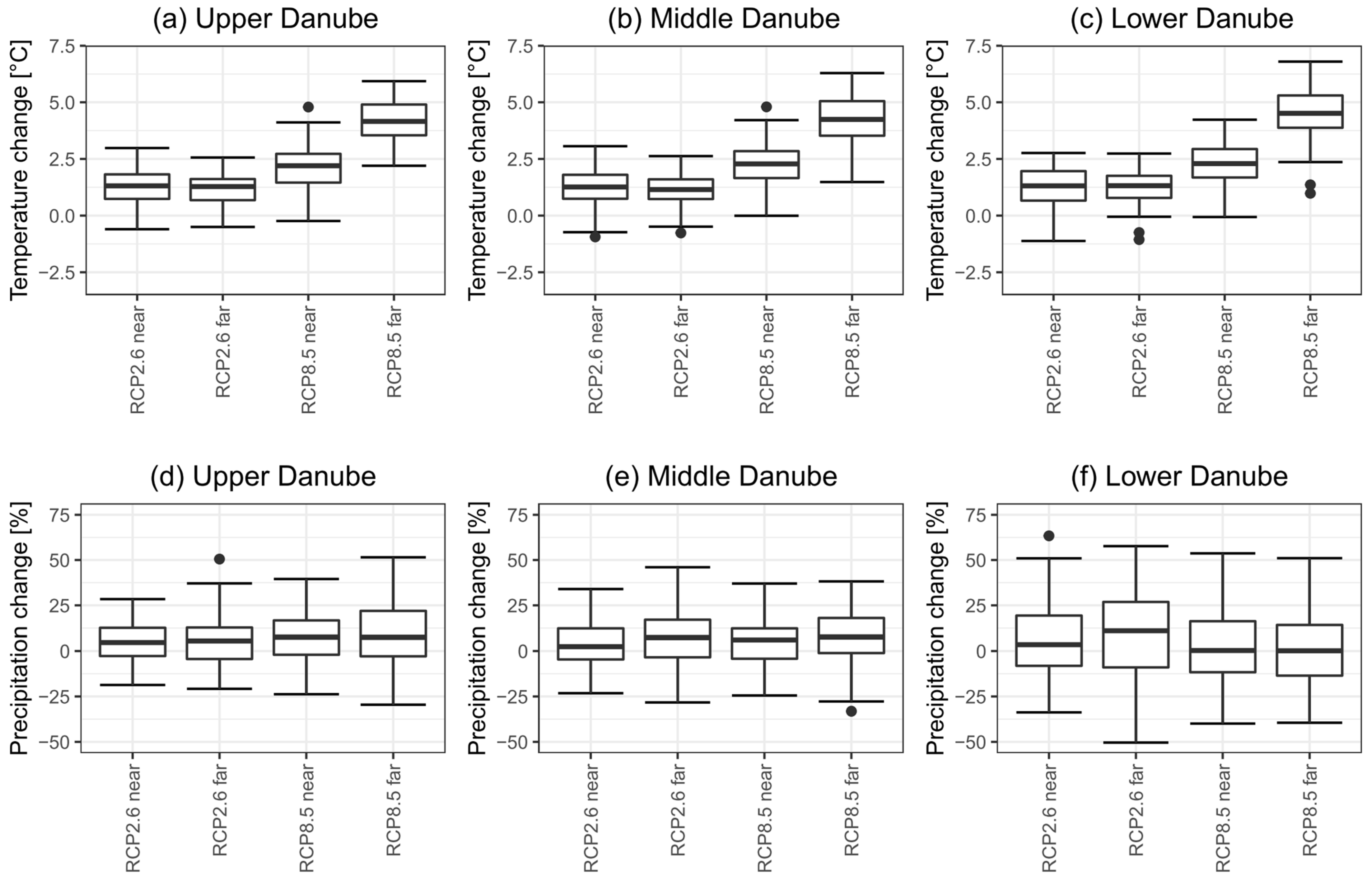
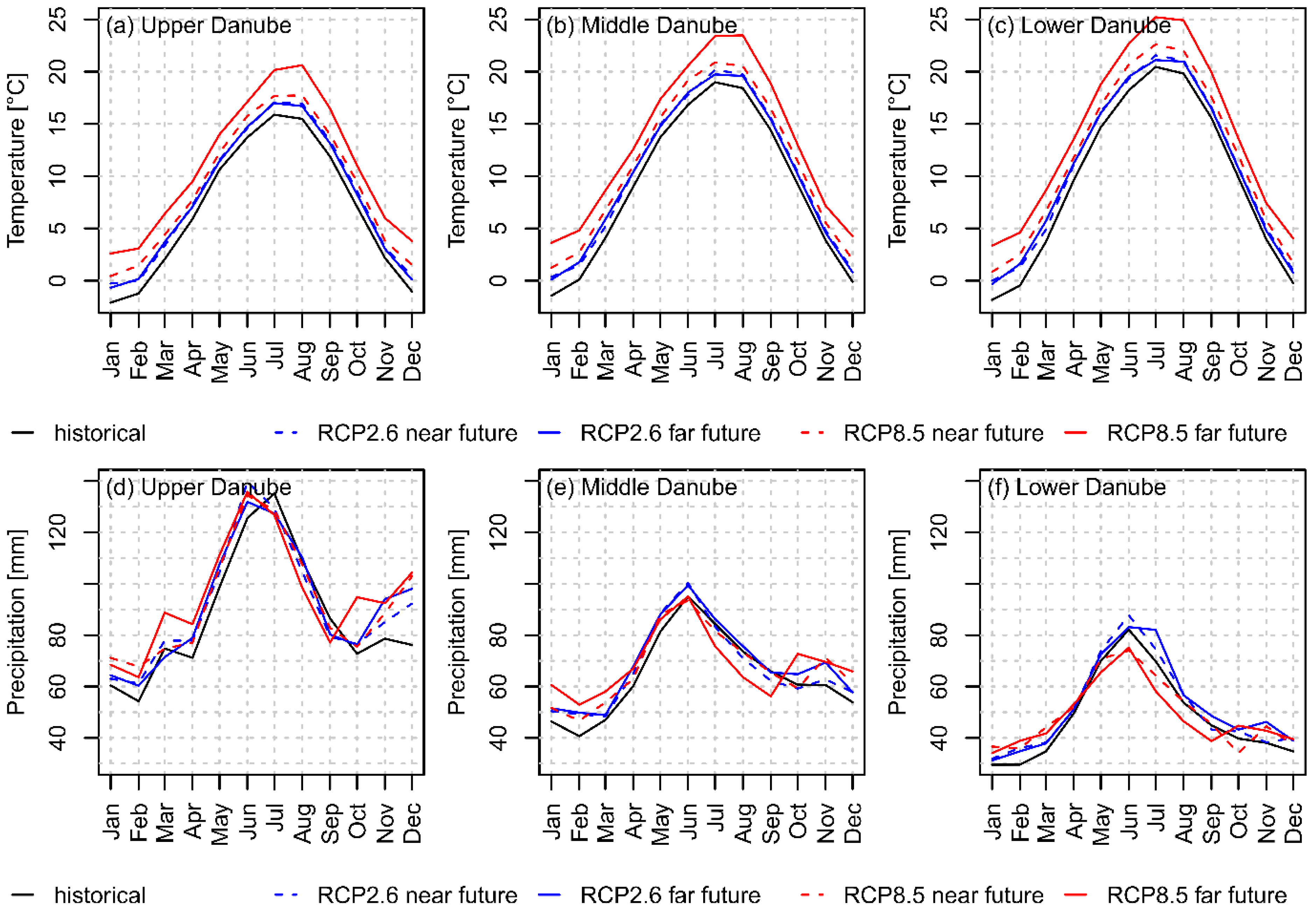
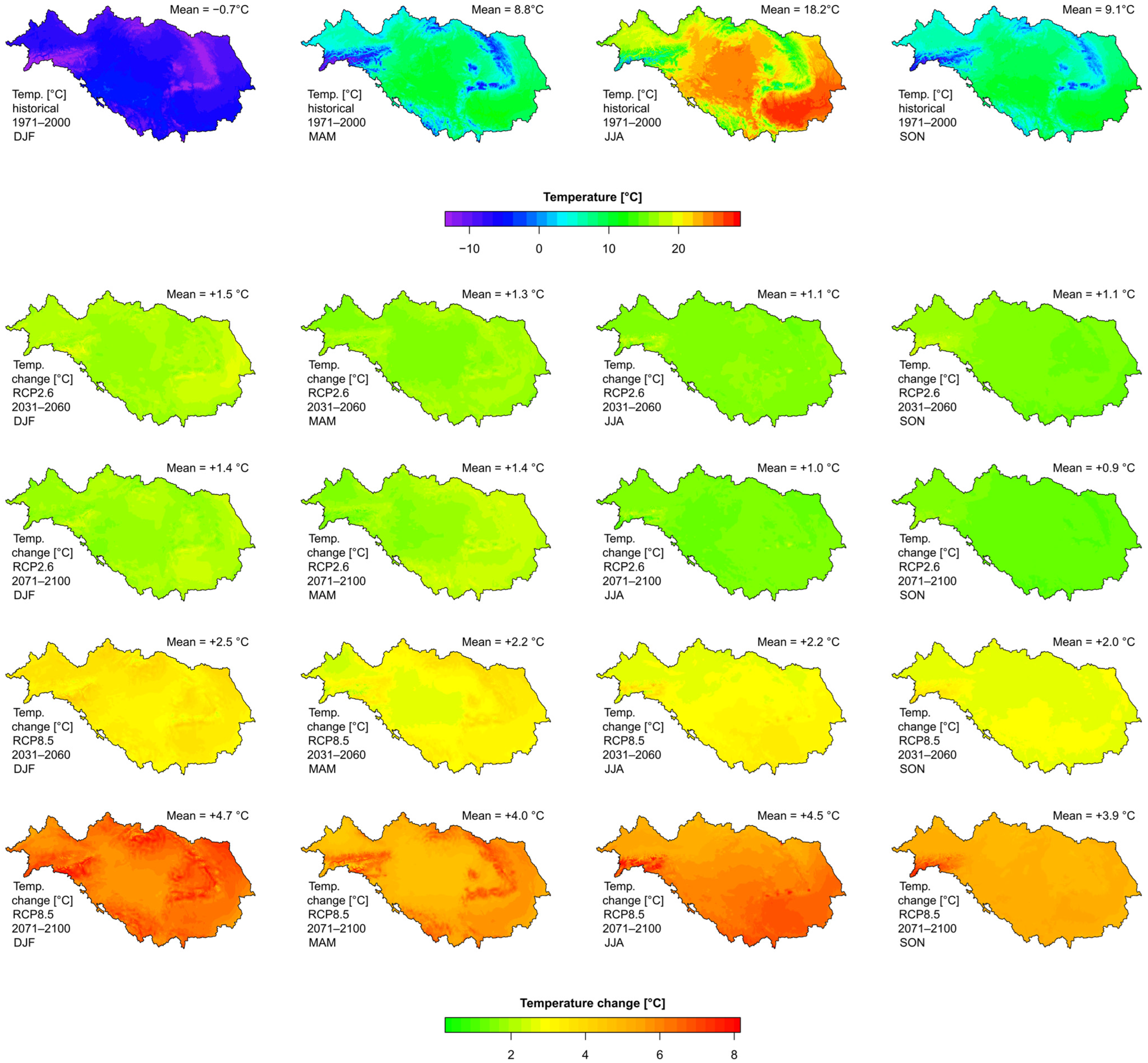
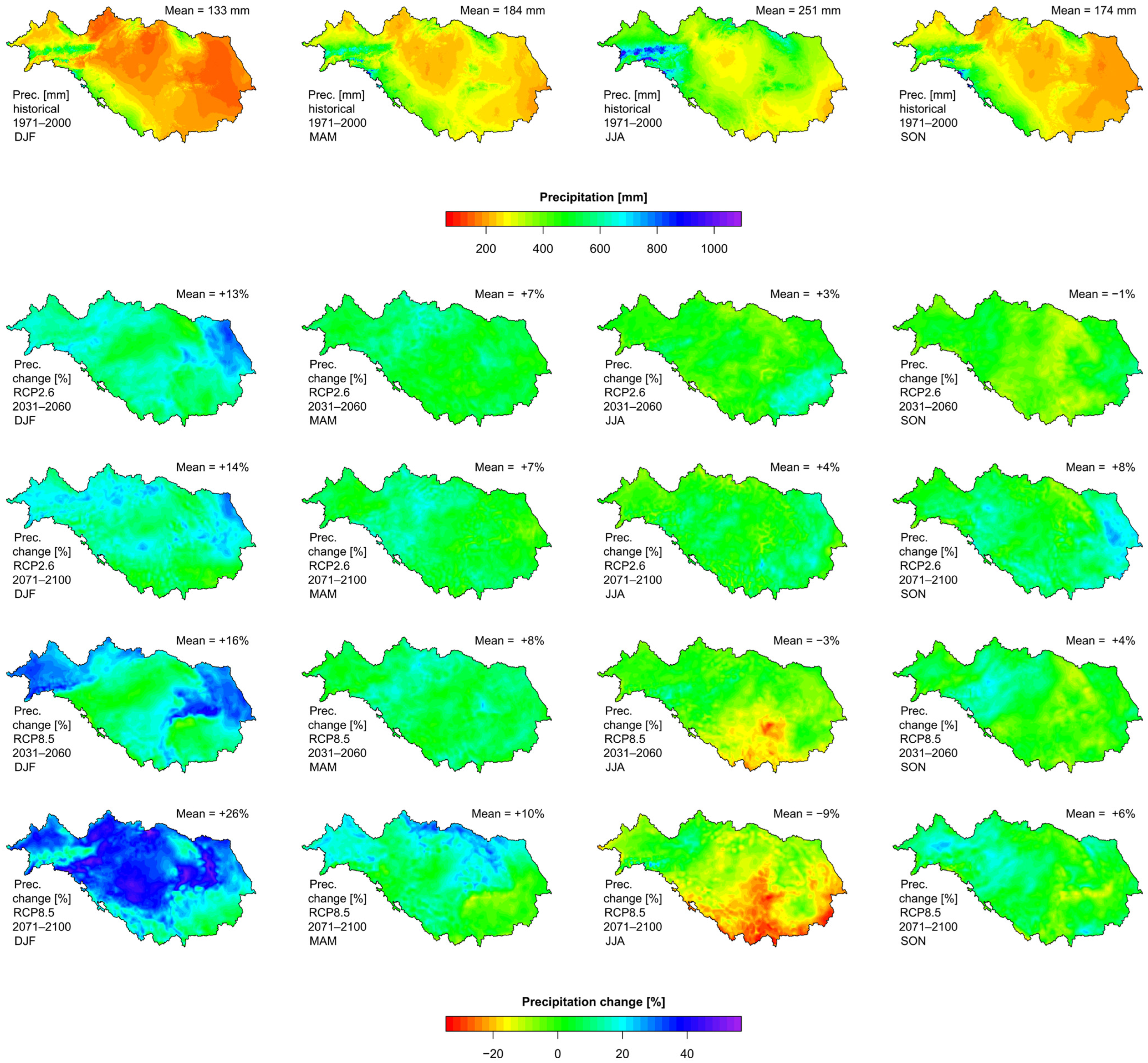

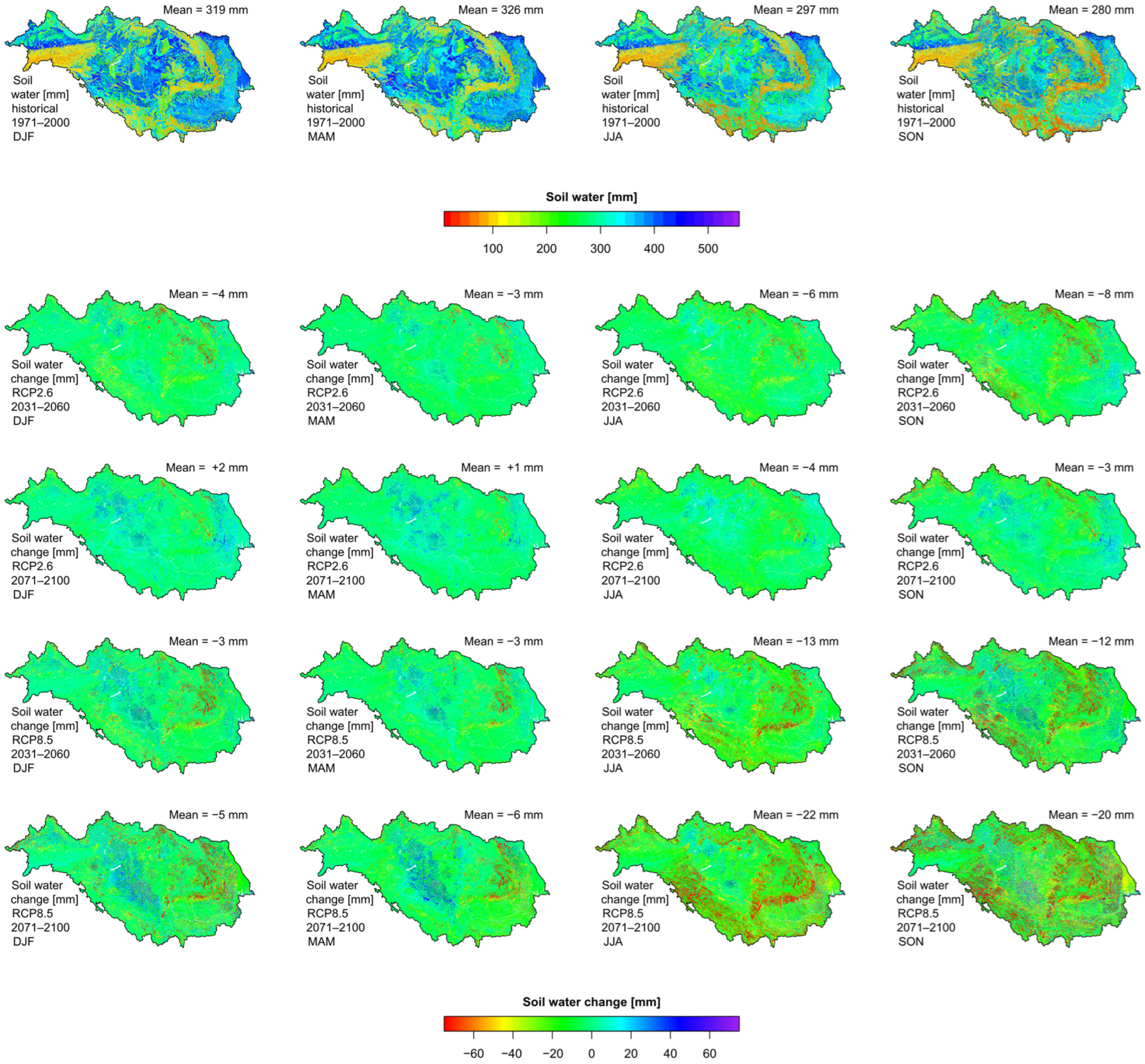



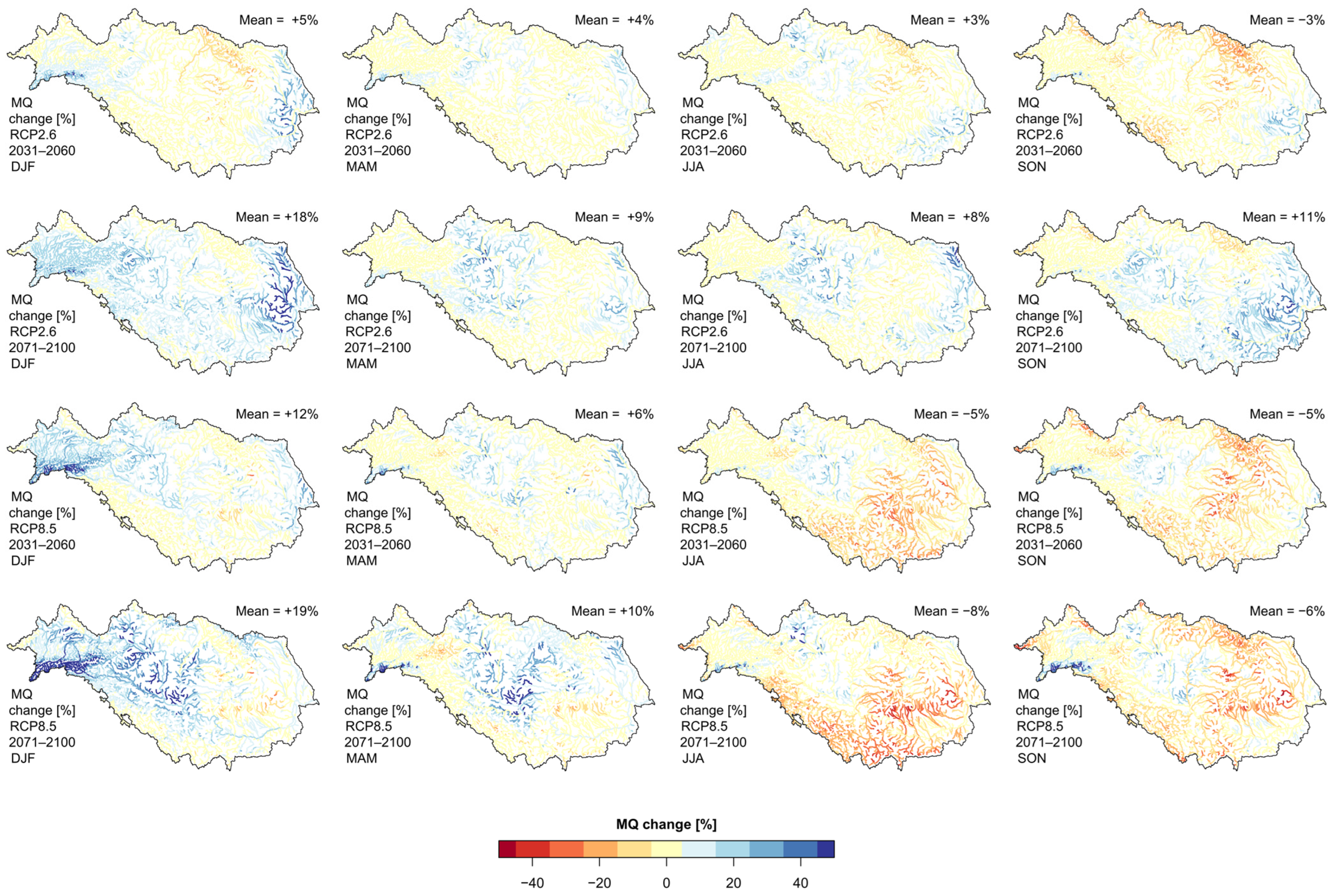
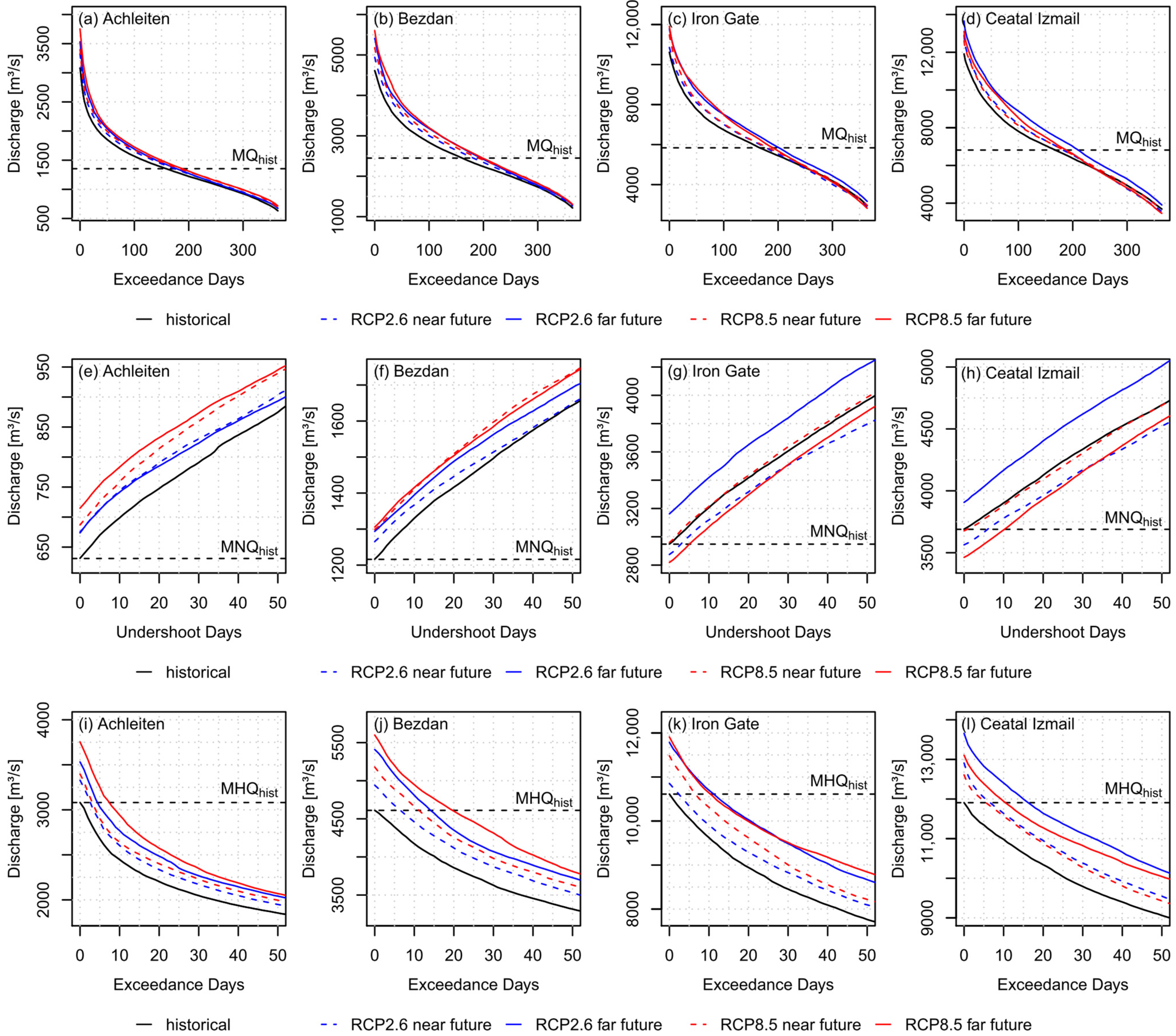
| Characteristics | Upper Danube | Middle Danube | Lower Danube |
|---|---|---|---|
| Major geomorphological units (not exhaustive) | Swabian/Franconian Alb, Bavarian Forest, Bohemian–Moravian Highland, Alpine Foreland, Northern Calcareous and Central Alps | Carpathians, Carnic Alps, Karawanks, Julian Alps, Dinarides, Pannonian Basin, Transylvanian Plateau | Carpathians, Balkans, Romanian/Bulgarian Plain, Dobrogea Hills, Moldavian Plateau |
| Terrain height range [m a.s.l.] | 303–3676 | 35–3449 | −2–2683 |
| Sub region area [km2] | 76,653 | 576,232 | 807,000 |
| Major tributary rivers (>20,000 km2 basin area) | Inn | Morava, Drava, Tisza, Sava, Velika Morava, | Olt, Siret, Prut |
| Outlet gauge | Achleiten | Iron Gate/Orsova | Ceatal Izmail |
| 287.7 | 44.0 | 0.6 |
| 2223 | 955 | 72 |
| 1417 | 5430 | 6401 |
| 659 | 2075 | 3045 |
| 3821 | 10,636 | 11,104 |
| Temperature [°C] | Precipitation [%] | |||||||
|---|---|---|---|---|---|---|---|---|
| Emission Scenario | Upper Danube | Middle Danube | Lower Danube | Danube Overall | Upper Danube | Middle Danube | Lower Danube | Danube Overall |
| RCP2.6 (2031–2060) | ||||||||
| Annual | +1.3 | +1.2 | +1.3 | +1.2 | +4.6% | +3.7% | +6.5% | +4.5% |
| DJF * | +1.5 | +1.4 | +1.6 | +1.5 | +13.4% | +11.7% | +15.0% | +12.6% |
| MAM * | +1.2 | +1.2 | +1.4 | +1.3 | +6.4% | +7.2% | +5.6% | +6.7% |
| JJA * | +1.2 | +1.1 | +1.1 | +1.1 | +1.1% | +0.6% | +6.6% | +2.1% |
| SON * | +1.3 | +1.1 | +1.0 | +1.1 | +1.4% | −1.6% | +1.1% | −0.7% |
| RCP2.6 (2071–2100) | ||||||||
| Annual | +1.2 | +1.2 | +1.3 | +1.2 | +5.5% | +7.1% | +8.6% | +7.2% |
| DJF | +1.3 | +1.4 | +1.5 | +1.4 | +16.7% | +12.9% | +11.8% | +13.2% |
| MAM | +1.2 | +1.4 | +1.6 | +1.4 | +5.4% | +8.6% | +4.7% | +7.3% |
| JJA | +1.1 | +1.0 | +1.0 | +1.0 | −0.1% | +3.3% | +7.8% | +3.8% |
| SON | +1.1 | +0.9 | +0.9 | +0.9 | +5.3% | +6.6% | +12.5% | +7.6% |
| RCP8.5 (2031–2060) | ||||||||
| Annual | +2.1 | +2.2 | +2.3 | +2.2 | +7.1% | +5.1% | +2.8% | +4.9% |
| DJF | +2.6 | +2.5 | +2.5 | +2.5 | +26.6% | +13.3% | +16.9% | +15.9% |
| MAM | +1.9 | +2.2 | +2.4 | +2.2 | +5.5% | +8.6% | +8.2% | +8.1% |
| JJA | +2.0 | +2.1 | +2.3 | +2.2 | +0.2% | −1.9% | −6.5% | −2.6% |
| SON | +2.0 | +2.0 | +2.0 | +2.0 | +3.8% | +4.7% | +1.0% | +3.8% |
| RCP8.5 (2071–2100) | ||||||||
| Annual | +4.2 | +4.2 | +4.4 | +4.3 | +9.8% | +7.0% | +0.4% | +5.9% |
| DJF | +4.6 | +4.7 | +4.8 | +4.7 | +23.8% | +27.3% | +19.8% | +25.3% |
| MAM | +3.8 | +3.9 | +4.3 | +4.0 | +16.2% | +12.0% | +3.9% | +10.7% |
| JJA | +4.3 | +4.4 | +4.8 | +4.5 | −2.4% | −7.4% | −12.6% | −7.9% |
| SON | +4.1 | +3.8 | +3.9 | +3.9 | +11.1% | +6.0% | +2.9% | +6.1% |
| Emission Scenario | Upper Danube (Achleiten) | Middle Danube (Bezdan) | Drava (Dravasza-bolcs) | Sava (Sremska Mitrovica) | Mures (Nagylak) | Tisza (Senta) | Siret (Lungoci) | Lower Danube (Ceatal Izmail) |
|---|---|---|---|---|---|---|---|---|
| RCP2.6 (2031–2060) | ||||||||
| Annual | +4.6% | +4.8% | +6.4% | −0.9% | −0.8% | −4.0% | +4.4% | +2.8% |
| DJF * | +9.2% | +7.8% | +11.6% | +2.1% | −1.8% | −8.3% | +16.3% | +3.4% |
| MAM * | +4.6% | +5.5% | +7.4% | +0.6% | +5.0% | +2.5% | +9.5% | +4.4% |
| JJA * | +5.9% | +7.9% | +8.9% | −0.3% | −2.8% | −2.5% | −0.8% | +5.1% |
| SON * | −1.8% | −3.1% | −1.9% | −8.0% | −3.3% | −9.3% | +0.5% | −3.1% |
| RCP2.6 (2071–2100) | ||||||||
| Annual | +6.9% | +9.5% | +12.7% | +9.6% | +7.4% | +5.6% | +20.0% | +10.7% |
| DJF | +20.4% | +20.2% | +16.6% | +13.5% | +14.7% | +7.8% | +37.6% | +16.9% |
| MAM | +3.0% | +6.8% | +10.7% | +8.0% | +7.1% | +8.1% | +11.6% | +8.8% |
| JJA | +3.8% | +7.8% | +13.0% | +8.5% | −0.2% | +3.5% | +16.0% | +9.5% |
| SON | +0.6% | +2.8% | +10.9% | +7.4% | +14.9% | +3.3% | +23.9% | +7.4% |
| RCP8.5 (2031–2060) | ||||||||
| Annual | +7.2% | +8.1% | +9.0% | −2.0% | −3.9% | +0.1% | −4.3% | +3.1% |
| DJF | +22.5% | +21.1% | +17.3% | +3.1% | +9.8% | +5.7% | +11.5% | +12.1% |
| MAM | +4.4% | +6.2% | +6.1% | +0.5% | +7.2% | +5.4% | +13.0% | +6.0% |
| JJA | +2.8% | +4.7% | +5.9% | −7.1% | −13.5% | −2.7% | −16.5% | −1.5% |
| SON | −0.2% | +0.0% | +8.1% | −6.7% | −14.1% | −9.2% | −10.6% | −4.4% |
| RCP8.5 (2071–2100) | ||||||||
| Annual | +10.5% | +11.5% | +9.4% | −0.2% | +0.6% | +4.5% | −5.2% | +5.2% |
| DJF | +26.4% | +27.7% | +33.3% | +14.7% | +13.2% | +13.1% | +9.5% | +19.1% |
| MAM | +9.2% | +10.0% | +8.5% | +7.4% | +17.3% | +18.3% | +13.0% | +11.8% |
| JJA | +3.3% | +6.2% | +0.8% | −16.7% | −11.1% | −3.5% | −14.7% | −2.9% |
| SON | +4.1% | +2.0% | +0.6% | −11.9% | −11.5% | −10.8% | −17.1% | −7.2% |
Disclaimer/Publisher’s Note: The statements, opinions and data contained in all publications are solely those of the individual author(s) and contributor(s) and not of MDPI and/or the editor(s). MDPI and/or the editor(s) disclaim responsibility for any injury to people or property resulting from any ideas, methods, instructions or products referred to in the content. |
© 2022 by the authors. Licensee MDPI, Basel, Switzerland. This article is an open access article distributed under the terms and conditions of the Creative Commons Attribution (CC BY) license (https://creativecommons.org/licenses/by/4.0/).
Share and Cite
Probst, E.; Mauser, W. Climate Change Impacts on Water Resources in the Danube River Basin: A Hydrological Modelling Study Using EURO-CORDEX Climate Scenarios. Water 2023, 15, 8. https://doi.org/10.3390/w15010008
Probst E, Mauser W. Climate Change Impacts on Water Resources in the Danube River Basin: A Hydrological Modelling Study Using EURO-CORDEX Climate Scenarios. Water. 2023; 15(1):8. https://doi.org/10.3390/w15010008
Chicago/Turabian StyleProbst, Elisabeth, and Wolfram Mauser. 2023. "Climate Change Impacts on Water Resources in the Danube River Basin: A Hydrological Modelling Study Using EURO-CORDEX Climate Scenarios" Water 15, no. 1: 8. https://doi.org/10.3390/w15010008
APA StyleProbst, E., & Mauser, W. (2023). Climate Change Impacts on Water Resources in the Danube River Basin: A Hydrological Modelling Study Using EURO-CORDEX Climate Scenarios. Water, 15(1), 8. https://doi.org/10.3390/w15010008





